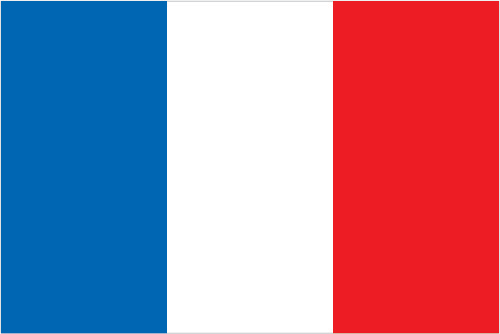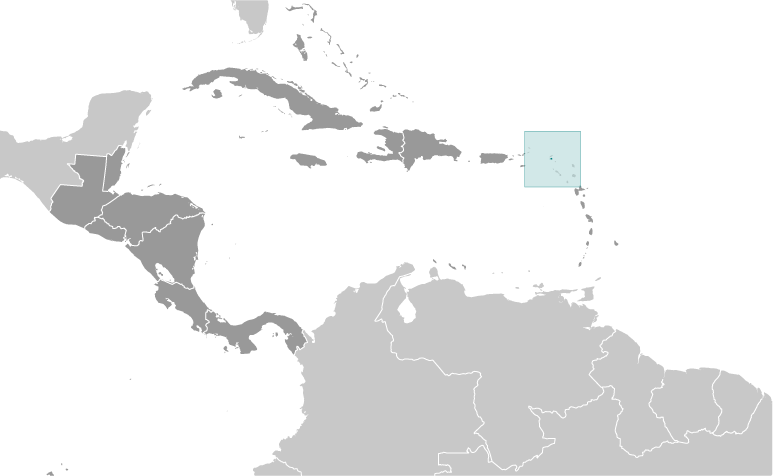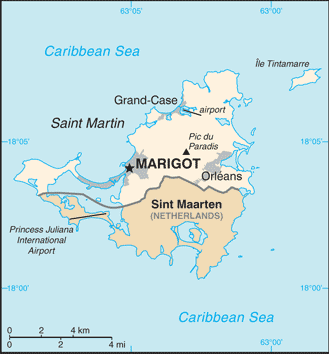



Central America and Caribbean :: SAINT MARTIN
Introduction :: SAINT MARTIN
-
Although sighted by Christopher COLUMBUS in 1493 and claimed for Spain, it was the Dutch who occupied the island in 1631 and set about exploiting its salt deposits. The Spanish retook the island in 1633, but continued to be harassed by the Dutch. The Spanish finally relinquished Saint Martin to the French and Dutch, who divided it between themselves in 1648. Friction between the two sides caused the border to frequently fluctuate over the next two centuries, with the French eventually holding the greater portion of the island (about 57%). The cultivation of sugar cane introduced African slavery to the island in the late 18th century; the practice was not abolished until 1848. The island became a free port in 1939; the tourism industry was dramatically expanded during the 1970s and 1980s. In 2003, the populace of Saint Martin voted to secede from Guadeloupe and in 2007, the northern portion of the island became a French overseas collectivity. In 2010, the southern Dutch portion of the island became the independent nation of Sint Maarten within the Kingdom of the Netherlands.
Geography :: SAINT MARTIN
-
Caribbean, located in the Leeward Islands (northern) group; French part of the island of Saint Martin in the Caribbean Sea; Saint Martin lies east of the US Virgin Islands18 05 N, 63 57 WCentral America and the Caribbeantotal: 54.4 sq kmland: 54.4 sq kmwater: NEGLcountry comparison to the world: 231more than one-third the size of Washington, DCtotal: 16 kmborder countries (1): Sint Maarten 16 km58.9 km (for entire island)temperature averages 27-29 degrees Celcius all year long; low humidity, gentle trade winds, brief, intense rain showers; hurricane season stretches from July to Novemberlowest point: Caribbean Ocean 0 mhighest point: Pic du Paradis 424 msaltsubject to hurricanes from July to Novemberfreshwater supply is dependent on desalinization of sea waterthe island of Saint Martin is the smallest landmass in the world shared by two independent states, the French territory of Saint Martin and the Dutch territory of Sint Maarten
People and Society :: SAINT MARTIN
-
Creole (mulatto), black, Guadeloupe Mestizo (French-East Asia), white, East IndianFrench (official), English, Dutch, French Patois, Spanish, Papiamento (dialect of Netherlands Antilles)Roman Catholic, Jehovah's Witnesses, Protestant, Hindu31,754 (July 2015 est.)country comparison to the world: 2170-14 years: 26.51% (male 4,192/female 4,225)15-24 years: 10.58% (male 1,682/female 1,677)25-54 years: 47.05% (male 7,101/female 7,838)55-64 years: 8.57% (male 1,267/female 1,455)65 years and over: 7.3% (male 1,033/female 1,284) (2015 est.)total: 31.8 yearsmale: 30.7 yearsfemale: 32.7 years (2014 est.)at birth: 1.04 male(s)/female0-14 years: 0.99 male(s)/female15-24 years: 1 male(s)/female25-54 years: 0.91 male(s)/female55-64 years: 0.87 male(s)/female65 years and over: 0.8 male(s)/femaletotal population: 0.93 male(s)/female (2015 est.)
Government :: SAINT MARTIN
-
conventional long form: Overseas Collectivity of Saint Martinconventional short form: Saint Martinlocal long form: Collectivite d'outre mer de Saint-Martinlocal short form: Saint-Martinoverseas collectivity of Francename: Marigotgeographical coordinates: 18 04 N, 63 05 Wtime difference: UTC-4 (1 hour ahead of Washington, DC, during Standard Time)none (overseas collectivity of France)Fete de la Federation, 14 July (1789); note - local holiday is Schoalcher Day (Slavery Abolition Day) 12 July (1848)4 October 1958 (French Constitution) (2013)French civil law18 years of age, universalchief of state: President Francois HOLLANDE (since 15 May 2012); represented by Deputy Prefect Philippe CHOPIN (since 16 November 2011)head of government: President of Territorial Council Aline HANSON (since 17 April 2013)cabinet: Executive Council; note - there is also an advisory economic, social, and cultural councilelections/appointments: French president directly elected by absolute majority popular vote in 2 rounds if needed for a 5-year term (eligible for a second term); prefect appointed by French president on the advice of French Ministry of Interior; president of Territorial Council elected by its members for a 5-year term; election last held on 17 April 2013 (next to be held in 2018)election results: Aline HANSON elected president by the Territorial Councildescription: unicameral Territorial Council (23 seats; members directly elected by absolute majority vote to serve 5-year terms)note: Saint Martin elects one member to the French Senate; election last held on 28 September 2014 (next to be held not later than September 2017); results - percent of vote by party - NA; seats by party - UMP 1; one seat (shared with Saint Barthelemy) was elected to the French National Assembly on 17 June 2012 (next to be held by June 2017); results - percent of vote by party - NA; seats by party - UMP 1elections: last held on 18 and 25 March 2012 (next to be held in July 2017)election results: percent of seats by party - RRR 34.1%, Team Daniel Gibbs 2012 32%, UPP 13.3%, Saint-Martin pour tous 9.4%, other 11.2%; seats by party - NA; second round, percent of seats by party - RRR 56.9%, Team Daniel Gibbs 43.1%; seats by party - RRR 17, Team Daniel Gibbs 6Rassemblement Responsabilite Reussite or RRR [Alain RICHARDSON]Reussir Saint-MartinSaint-Martin pour tous [Martha OGOUNDELE]Team Daniel Gibbs [Daniel GIBBS]Union Pour le Progres or UPP [Louis-Constant FLEMING]NAUPUnone (overseas collectivity of France)none (overseas collectivity of France)the flag of France is usedbrown pelicanname: "O Sweet Saint Martin's Land"lyrics/music: Gerard KEMPSnote: the song, written in 1958, is used as an unofficial anthem for the entire island (both French and Dutch sides); as a collectivity of France, in addition to the local anthem, "La Marseillaise" remains official on the French side (see France); as a constituent part of the Kingdom of the Netherlands, in addition to the local anthem, "Het Wilhelmus" remains official on the Dutch side (see Netherlands)
Economy :: SAINT MARTIN
-
The economy of Saint Martin centers around tourism with 85% of the labor force engaged in this sector. Over one million visitors come to the island each year with most arriving through the Princess Juliana International Airport in Sint Maarten. No significant agriculture and limited local fishing means that almost all food must be imported. Energy resources and manufactured goods are also imported, primarily from Mexico and the United States. Saint Martin is reported to have the highest per capita income in the Caribbean.$561.5 million (2005 est.)country comparison to the world: 212$561.5 million (2005 est.)$19,300 (2005 est.)country comparison to the world: 86agriculture: 1%industry: 15%services: 84% (2000)tourism, light industry and manufacturing, heavy industry17,300 (2008 est.)country comparison to the world: 21385% directly or indirectly employed in tourist industrycrude petroleum, food, manufactured itemseuros (EUR) per US dollar -0.7489 (2014 est.)0.7634 (2013 est.)0.7752 (2012 est.)0.7185 (2011 est.)0.755 (2010 est.)
Communications :: SAINT MARTIN
-
general assessment: fully integrated accessdomestic: direct dial capability with both fixed and wireless systemsinternational: country code - 590; undersea fiber-optic cable provides voice and data connectivity to Puerto Rico and Guadeloupe (2009)1 local TV station; access to about 20 radio stations, including RFO Guadeloupe radio broadcasts via repeater (2008)AM 0, FM 3, shortwave 0 (2007).mf; note - .gp, the Internet country code for Guadeloupe, and .fr, the Internet country code for France, might also be encountered
Transportation :: SAINT MARTIN
-
1 (2013)country comparison to the world: 233total: 1914 to 1,523 m: 1 (2013)nearest airport for international flights is Princess Juliana International Airport (SXM) located on Sint Maarten
Military :: SAINT MARTIN
-
males age 16-49: 6,435females age 16-49: 6,967 (2010 est.)male: 168female: 168 (2010 est.)defense is the responsibility of France
